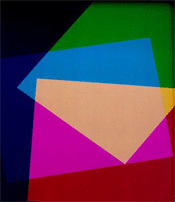Understated, conceptual gestures predominate in "Quiet Politics," a timely group exhibition currently on display at New York's Zwirner & Wirth. Felix Gonzalez-Torres' single string of lights "Untitled" (for New York) (1992) hangs from the ceiling of the front room and ends, in a tangle, on the floor: an arrangement, at once elegant and casual, that the artist relinquishes to the person installing the work. Lining the gallery hallway are photograms from Lisa Oppenheim's series Multicultural Crayon Displacement (2008), in which the artist employs a vintage, additive color process to generate deceptively straightforward geometric abstractions. Color rectangles overlap in arrays of hybrid tones and, at their center, a fleshy pigment corresponds to one of the crayons in Crayola Company's 'multicultural' set. Oppenheim's additive production of multicultural colors thus parallels the way race is constructed and categorized in social discourse. A similar disjunction between representation and narrative is evident in Christopher Williams' eerie photographs of Harvard University Botanical Museum's collection of nineteenth- and early twentieth-century life-size, glass flowers. The species the artist chose were particular to twenty-seven countries flagged in a 1986 Commission on International Humanitarian Issues report for human rights abuses. As with Oppenheim's series, Williams' titles signal the conceptual envelope for these beguiling still-lives, listing the names of their origin countries and genus. While other strategies also enter the exhibition, this marriage of formal sophistication and social and political inquiry characterizes the most resonant works, underscoring a point recently made by Francis Alÿs, during his last exhibition at David Zwirner: "sometimes doing something poetic can become political, and sometimes doing something political can become poetic." - Tyler Coburn
Image: Lisa Oppenheim, Multicultural Crayon Displacement (Peach, II), 2008